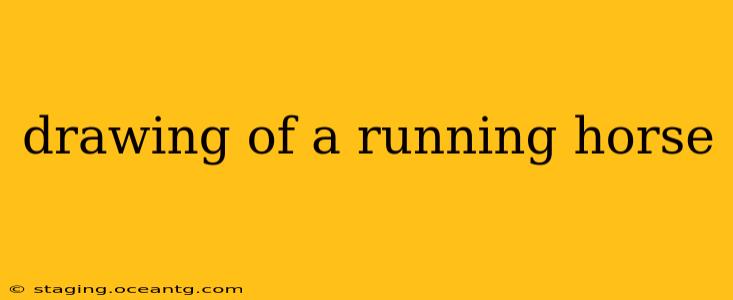How to Draw a Running Horse: A Step-by-Step Guide for Beginners and Beyond
Drawing a running horse can seem daunting, but with the right approach and a little practice, you can capture the grace and power of this magnificent animal. This guide will take you through the process, from basic shapes to adding details, catering to both beginners and those looking to refine their skills. We'll even tackle some common questions people have about drawing horses in motion.
Understanding Horse Anatomy: The Foundation of a Good Drawing
Before diving into the drawing itself, understanding the basic anatomy of a horse is crucial. Observe real horses, photos, or videos to familiarize yourself with their musculature and skeletal structure. This will help you understand how the body moves and bends while running. Focus on the key features like the long neck, powerful legs, and flowing mane and tail.
Step-by-Step Drawing Process:
-
The Basic Pose: Begin by sketching a simplified outline of the horse's body using basic shapes. Think of a series of elongated ovals and circles to represent the torso, head, and legs. This helps establish the overall posture and proportions. For a running horse, consider a slightly diagonal line for the body, reflecting the forward momentum.
-
Refining the Body: Once you have the basic shapes in place, start refining the outline. Smooth out the curves, paying attention to the natural flow of the horse's body. Add the details of the legs, ensuring they are correctly positioned for a running gait. Remember that the legs move in a rhythmic pattern; understanding this sequence is key to depicting a realistic running horse.
-
Adding Details: Now, it's time to add details such as the head, mane, tail, and musculature. The head should be proportionate to the body and express the horse's energy and movement. The mane and tail should flow dynamically, capturing the motion of the run. Subtly suggest the muscles under the skin, giving your horse a more realistic and powerful appearance.
-
Refining the Lines: Carefully refine your lines, correcting any proportions or misalignments. Erase unnecessary guidelines. Use varying line weights to add depth and texture to your drawing. Thicker lines can define the contours, while thinner lines can add finer details.
-
Adding Shading and Texture: Finally, add shading and texture to your drawing using pencils or other shading tools. This will bring your horse to life, creating a sense of depth and volume. Use light and shadow to emphasize the muscles and movement, highlighting the dynamic nature of the horse's run.
H2: What are some easy ways to draw a running horse?
Start with simplified shapes, focusing on capturing the overall posture and movement before adding details. Practice drawing the horse's legs in different positions to understand the gait. Use references, such as photos or videos of running horses, to guide your drawing. Don't be afraid to experiment and make mistakes; learning comes through practice.
H2: How do you draw a horse running fast?
To depict a fast run, exaggerate the extension of the legs and the curve of the body. The horse's head may be slightly lowered, and the mane and tail would flow dramatically. Focus on the movement and energy of the horse, showing its powerful stride and speed.
H2: How do I draw a horse's legs while running?
Horses' legs move in a coordinated sequence. Study images or videos of running horses to observe the pattern of their leg movements. Pay attention to the angles and positions of the legs at different stages of the stride. Practice drawing individual legs in different positions before integrating them into your overall drawing.
H2: What are some tips for drawing realistic horse anatomy?
Observe real horses or use high-quality reference images. Study horse anatomy books or online resources to understand the musculature and skeletal structure. Pay attention to the proportions and relationships between different body parts. Practice drawing individual parts before putting them together to form a complete horse.
This guide provides a foundation for drawing a running horse. Remember that practice is key; the more you draw, the better you will become at capturing the beauty and power of this majestic animal. Don't be discouraged if your first attempts aren't perfect; keep practicing, and you'll soon see improvement. Enjoy the process!
